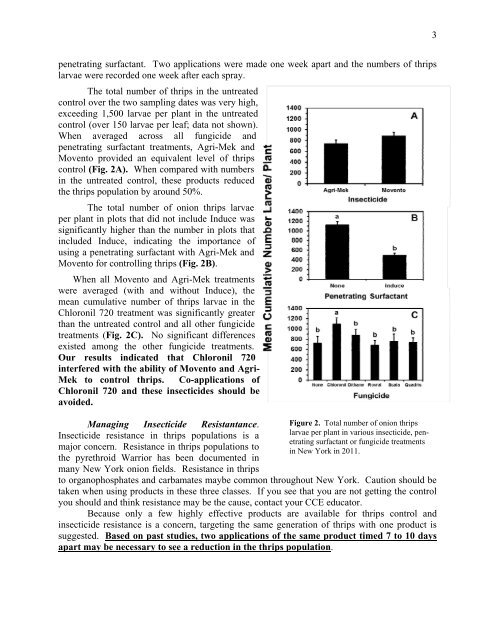How to Win the Battle Against Onion Thrips - Cornell University
How to Win the Battle Against Onion Thrips - Cornell University
How to Win the Battle Against Onion Thrips - Cornell University
You also want an ePaper? Increase the reach of your titles
YUMPU automatically turns print PDFs into web optimized ePapers that Google loves.
3penetrating surfactant. Two applications were made one week apart and <strong>the</strong> numbers of thripslarvae were recorded one week after each spray.The <strong>to</strong>tal number of thrips in <strong>the</strong> untreatedcontrol over <strong>the</strong> two sampling dates was very high,exceeding 1,500 larvae per plant in <strong>the</strong> untreatedcontrol (over 150 larvae per leaf; data not shown).When averaged across all fungicide andpenetrating surfactant treatments, Agri-Mek andMoven<strong>to</strong> provided an equivalent level of thripscontrol (Fig. 2A). When compared with numbersin <strong>the</strong> untreated control, <strong>the</strong>se products reduced<strong>the</strong> thrips population by around 50%.The <strong>to</strong>tal number of onion thrips larvaeper plant in plots that did not include Induce wassignificantly higher than <strong>the</strong> number in plots thatincluded Induce, indicating <strong>the</strong> importance ofusing a penetrating surfactant with Agri-Mek andMoven<strong>to</strong> for controlling thrips (Fig. 2B).When all Moven<strong>to</strong> and Agri-Mek treatmentswere averaged (with and without Induce), <strong>the</strong>mean cumulative number of thrips larvae in <strong>the</strong>Chloronil 720 treatment was significantly greaterthan <strong>the</strong> untreated control and all o<strong>the</strong>r fungicidetreatments (Fig. 2C). No significant differencesexisted among <strong>the</strong> o<strong>the</strong>r fungicide treatments.Our results indicated that Chloronil 720interfered with <strong>the</strong> ability of Moven<strong>to</strong> and Agri-Mek <strong>to</strong> control thrips. Co-applications ofChloronil 720 and <strong>the</strong>se insecticides should beavoided.Managing Insecticide Resistantance.Insecticide resistance in thrips populations is amajor concern. Resistance in thrips populations <strong>to</strong><strong>the</strong> pyrethroid Warrior has been documented inmany New York onion fields. Resistance in thripsFigure 2. Total number of onion thripslarvae per plant in various insecticide, penetratingsurfactant or fungicide treatmentsin New York in 2011.<strong>to</strong> organophosphates and carbamates maybe common throughout New York. Caution should betaken when using products in <strong>the</strong>se three classes. If you see that you are not getting <strong>the</strong> controlyou should and think resistance may be <strong>the</strong> cause, contact your CCE educa<strong>to</strong>r.Because only a few highly effective products are available for thrips control andinsecticide resistance is a concern, targeting <strong>the</strong> same generation of thrips with one product issuggested. Based on past studies, two applications of <strong>the</strong> same product timed 7 <strong>to</strong> 10 daysapart may be necessary <strong>to</strong> see a reduction in <strong>the</strong> thrips population.
















